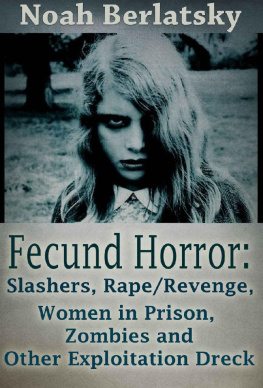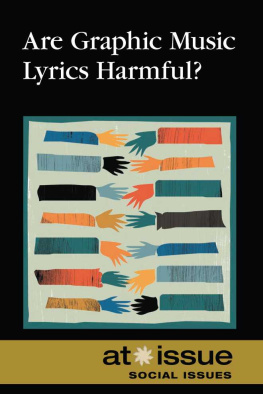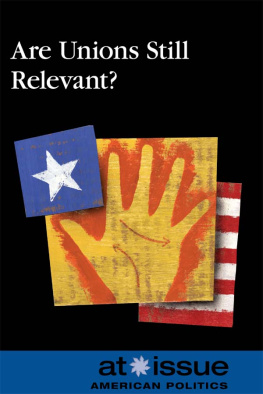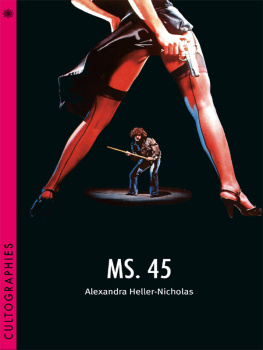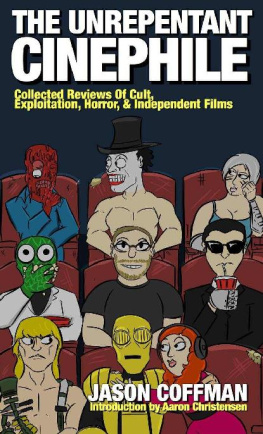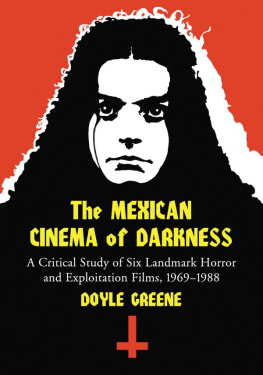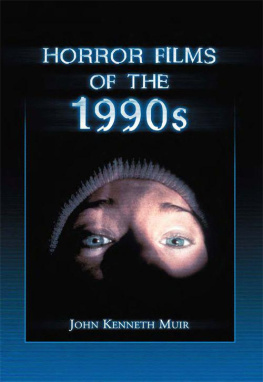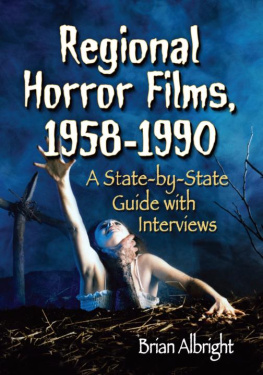Table of Contents
Fecund Horror

Slashers, Rape/Revenge,
Women in Prison, Zombies
And Other Exploitation Dreck
c. 2016 by Noah Berlatsky
Cover design by Vom Marlowe. Cover image from Night of the Living Dead , which is conveniently out of copyright.
"Introduction" "The Top Ten Rape/Revenge Films" and "Disgusting Women" are new for this collection. "Men In Women in Prison" and "The Child Is Father of the Child" were first published in Bright Lights Film Journal . "Embrace the Exploitation" first appeared in the Chicago Reader , and in expanded form in Bright Lights Film Journal . The essay "Fecund Horror" was first published on the Gay Utopia website. "I Spit On Your Quietism" and "Waiting for the Revolution" were first published in Splice Today . "Rape the Children Well" was first published in the Guardian . All the rest of the essays first appeared at The Hooded Utilitarian .
Table of Contents
Introduction: On Halloween
Series
Introduction:
Looking Wrong at Halloween
The beginning of John Carpenter's 1978 Halloween puts the viewer, famously, behind the eyes of the killer. The shaky handheld camera watches six-year-old Michael Meyer's sister and her boyfriend as they flirt and then canoodleand then the perspective narrows as Michael puts on a Halloween mask. Through the eyeslits, you see Michael's nude sister as he stabs her and she thrashes and dies like Marion Crane in the Psycho shower scene before her. As in Psycho too, the nudity and the thrusting knife are blatantly sexual; intercourse presented as blood-soaked violence, and vice versa. You (yes, you, and you also) are the murderer in the act of murdering, and the rapist in the act of raping. The pleasure is in the visceral voyeuristic embodiment of the monster.
To watch Halloween , then, is to be transformed into a misogynist sex predator. Unpleasant? Perhaps, but not unexpected. In her classic 1975 essay Visual Pleasure and Narrative Cinema , Laura Mulvey warned you (and yes, you also) about just this sort of Hollywood narrative violence.
Today, Mulvey's theories are most often used as a way to talk about the objectification of women. When James Bond films gratuitously parade a bevy of not-very-attired young women across the screen, then those films are catering to the male gaze.
Mulvey would no doubt agree that Pussy Galore is pinned up on screen for scopophiliac male pleasure. But her conception of the male gaze was not just about pin ups. It was also about narrative. The male gaze works by framing women as sex objects. But it additionally works by framing men as active actors, swaggering through the narrative with heroic manliness. "As the spectator identifies with the main male protagonist, he projects his look on to that of his like, his screen surrogate, so that the power of the male protagonist as he controls events coincides with the active power of the erotic look, both giving a satisfying sense of omnipotence." The guy watching identifies with the guy on screen performing actions, so that looking and action become one exciting godlike rush. And that rush is consummated in the contemplation/possession of the female body, which is looked at and acted upon simultaneously, as Michael's eye-slits precede, mirror, and call into being the slashes of the knife.
Mulvey sees the male gaze as structuring entire films, not just individual scenes. And, sure enough, once the trope of looking through the killer's eyes becomes established at the opening of Halloween , the rest of the movie is all presented as if you might be looking through the killer's eyes, so that, with the aid of Carpenter's spooky score, every shot becomes an ominous foreshadowing. Completely normal car interiors, mundane suburban blocks, the inside of a bedroom, all are suffused with the gaze, which is also the threat of violent action. Michael does not even need to be onscreen; the gaze itself has entered the film on its own recognizance, looking for victims.
Halloween , then,fits perfectly into Mulvey's argumentso perfectly that it almost stops fitting. Michael is robbed of any personality but the gaze. His face is either carefully cropped offscreen, or hidden behind a mask. His only features are those the viewer provideswhich is to say, he has the viewer's features. In one scene Michael, having murdered hapless boyfriend Bob, covers himself in a sheet and dons Bob's glasses. Behind everydude's eyes the killer lurks, breathing hard while staring out eagerly at Bob's girlfriend's exposed breasts.
Michael, then, not only serves as Mulvey's point of identification, but actually symbolizes the point of identification. He both is, and, stands for, the online empowered sexist avatar of the male viewer.
But if Michael stands for an avatar, can he still function as an avatar? If the point of identification is reduced to a symbol, and a symbol alone, it's unlikely anyone's going to identify with it. A manikin represents everyperson, but few people have a strong sense of identification with a manikin.
Similarly, Michael resists the viewer's identification. As Carol Clover points out in her classic 1992 Men, Women and Chainsaws , slashers encourage viewers to identify with the victims, not the killers. The main character in Halloween is not really the faceless Michael, but Laurie Strode (Jamie Lee Curtis), the brainy high school good girl. When the camera wobbles and the ominous music comes up, you worry for and with Laurie. It's true that you do get the joy of righteously wielding the knifebut it's when Laurie stabs the evil killer Michael, not when Michael stabs Laurie (or anybody else.)
There is one moment where you are encouraged to identify with Michael directly, as a character. It's at the end of the first scene, when he walks outside the house after murdering his sister. His parents pull up, and his father, seizing the narrative action, pulls off the mask. Suddenly the camera shifts, and we're looking, not through Michael's eyes, but at him. He's a blonde six-year old boy (Adam Gunn) in a ridiculous clown suit, holding a giant knifeand looking confused and vulnerable. The gazer behind the eye slits is not a powerful narrative doer of sex and violence; he's just a little kid. Look and action come unwound and sit there, gazing at each other, like sad, bedraggled clowns. With knives.
Mulvey's essay is a critique of traditional Hollywood narrative cinema, like those James Bond movies. Halloween , too, arguably, is a critique of traditional Hollywood narrative cinemapresenting the gaze, and the pleasures of male identification, as a kind of dangerous, pitiful monstrosity.
The distrust of the straight Hollywood male gazer and his narrative is, I'd argue, one of the defining features of slashers, and of exploitation cinema in general. Not coincidentally, it's the feature that is consistently abandoned when the mainstream picks up exploitation material. The Silence of the Lambs is a slasher in which an empowered male character, Hannibal Lecter, drives the narrative, despite the female heroine's best efforts. Thelma and Louise is a rape/revenge thriller in which a male detective is provided as a point of identification and interpretation. Mad Max: Fury Road is a women-in-prison film that has Max wander in to give a stable male perspective on the women's struggles.
Exploitation films are not always more adventurous than the mainstream when it comes to gender, narrative, and looking. But often they are. As with the heroes of maintream cinema, Halloween's Dr. Sam Loomis (Donald Pleasence) shows up at the end to save the dayhe shoots Michael, dead. But when he looks over the railing to find the dead body, it's gone. The male gaze does not control, or close the film. Loomis' gaze goes awry.
Next page
